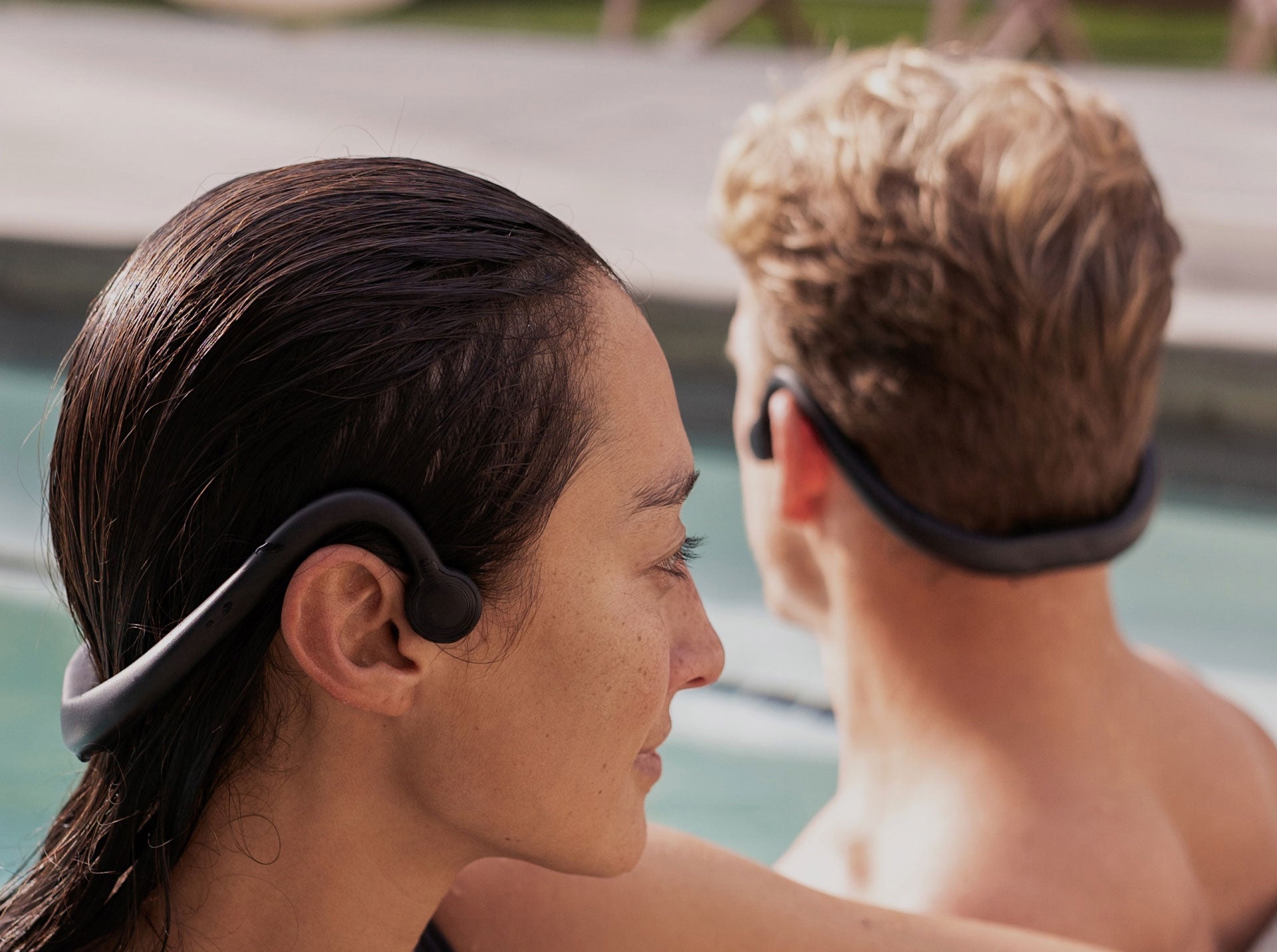What Are Bone Conduction Headphones?
Attention all audiophiles! We’ve got the scoop on the latest listening tech. You may have been driving past a cyclist wearing strange-looking headphones or noticed a swimmer at your local pool donning a pair of headphones that don’t even seem to fit over their ears.
What exactly is going on here? The answer is simple: Bone Conduction Headphones.
In today’s fast-paced world, where technology is constantly pushing the boundaries of what’s possible, bone conduction headphones are a revolutionary concept far beyond traditional headphone capabilities.
Let’s explore the origins of bone conduction technology, discuss its benefits, limitations, and potential applications, and help you choose the best earphones for your individual needs.
How Does Bone Conduction Technology Work?
The fundamental idea behind bone conduction technology is that sound waves can flow straight through the skull’s bones and into the inner ear, avoiding the eardrum altogether. While traditional headphones rely on speakers that sit in or on the ear canal, BCT headphones do not.
Bone conduction headphones use transducers to transform audio impulses into vibrations, unlike conventional headphones, which use speakers to produce sound waves that pass through the air and make contact with the eardrums.
The cochlea is stimulated, and the listener can sense the sounds as a result of these vibrations being transmitted through the bones of the skull. Because they produce distinct sounds without blocking the ear canal, bone conduction headphones are a desirable option for those who would prefer to hear ambient sounds beyond their music or podcasts.
Runners who want to be aware of their surroundings in noisy environments for safety purposes, cyclists who feel strongly about hearing the sounds of approaching vehicles, and swimmers who like to wear earplugs while swimming are all great candidates for bone conduction headphones.
When it comes to swimmers specifically, many are always on the lookout for headphones that work underwater and are also waterproof. This can be a challenge since Bluetooth technology is pretty ineffective at cutting through water.
In this case, many underwater BCT headphones have some sort of transmitter that boosts the Bluetooth signal, thus making it function even through water. You might wonder if bone conduction headphones are as effective as traditional ones. The truth is, they are a little different because they transmit sound differently.
You probably won’t get the exact same quality as super high-end noise-canceling headphones on the market today. However, for those with hearing loss issues or those with very specific audio needs, BCT is an absolute game-changer.
Why Was Bone Conduction Technology Created?
Speaking of unique needs, the reason BCT was invented is because of those who have issues with hearing loss. This technology was initially designed for use in hearing aids for those who are deaf or hard of hearing. In the medical field, bone conduction implants have been used to assist those with hearing impairments.
These types of hearing aids or hearing systems, also called osseointegrated or bone-anchored devices, work especially well for people with specific types of hearing loss. This includes but is not limited to:
- Sudden hearing loss
- Meniere’s Disease
- Acoustic Neuroma
- Congenital Atresia
- Malformation of the ear canal
This technology serves a worthy purpose: helping people hear. It is a happy accident that using bone conduction technology for headphones and listening pleasure rose to the forefront of the music tech industry.
How Do Bone Conduction Headphones Work With Your Devices?
This is a slightly complicated question and depends largely on your purposes. We already talked about the basics of BCT, so let’s explore some of the specifics regarding BCT headphones:
- They feature an open-ear design, perfect for those who want to hear outside sound
- They are reportedly very comfortable to wear
- They are great for tinnitus sufferers
- Many come with their own Bluetooth transmitters
- Design often involves a wraparound headband that goes around the back of the head/neck
- Connect easily to a phone or other device
When it comes to BCT headphones, you will find that the setup is surprisingly simple, especially if you are pairing the headphones to an existing device. If you will be using these types of headphones underwater, you definitely want to find headphones suitable for aqua usage, like Zygo’s headphones.
Some people don’t realize there’s much more to underwater headphones than waterproofing. Bluetooth signals simply do not travel well underwater, necessitating a little boost from additional technology.
Our Zygo headphones use a special transmitter that strengthens your device's existing signal and allows you to swim while listening to your favorite playlists, audiobooks, or podcasts. Setting up BCT headphones is user-friendly and quite simple.
The audio quality is crystal clear, and typically, the battery life is similar to that of many regular Bluetooth headphones, so it won’t feel vastly different from connecting any other set of traditional headphones to your device.
One thing that’s especially functional about this type of transmitter is that it can also be used for communication. The user can hear their favorite tunes while swimming, and someone outside of the pool can use it to communicate with a swimmer in real-time.
Just imagine the implications for swim coaches everywhere who want to communicate with their athletes on the go.
Are Bone Conduction Headphones Safe?
Bone conduction headphones are scientifically proven to be just as safe as any other wireless headphones or wireless earbuds. There is no data to suggest any real risk involved in wearing BCT headphones. Any downfalls are the same as one might find with regular headphones or earbuds, with one notable exception.
The vibration used in BCT headphones can take a little getting used to. Since this is a very different listening experience than most people are accustomed to, it can feel a little strange at first, prompting some to question whether it is safe. Rest assured, it is!
How Do I Choose the Best Bone Conduction Headphones?
When looking for your next pair of bone conduction headphones, there are a few things you should consider:
1. Fit
You definitely want to make sure that the headphones you select are comfortable. Remember that if you’re used to traditional earbuds, they might feel a little different at first but should ultimately fit you comfortably. Check to ensure the headphones you’re purchasing come with a money-back guarantee, just in case you don’t love the fit.
2. Range
Depending on the brand, you may find that different headphones have different ranges in which the radio waves can be transmitted. Our Zygo headphones, for example, have a range of up to 50 meters.
That’s more than enough for most swimmers! In addition, the transmitter can be up to 30 feet from the cell phone or other device, which is highly convenient if you need to have the transmitter on the edge of a pool but your device on a nearby bench or chair.
3. Battery Life
Make sure that the battery life of your headphones fits your needs. With today’s technology, most headphones boast pretty impressive battery life, but it’s worth checking out and doing a little comparison shopping.
4. Sound Quality
With BCT headphones, you can expect that the sound will be a little different than a pair of top-notch noise-canceling headphones, but you should still be able to enjoy a high-quality listening experience! Sound quality varies from product to product, so keep that in mind when making your decision.
5. Waterproof Performance (Maybe)
Are you planning to use your BCT headphones for swimming? Then, you definitely want to make sure that your headphones will perform well underwater. Believe it or not, not all BCT headphones are created equal in this regard.
Of course, plenty of people don’t plan to use their headphones in the pool, and for those, this might be less of a concern.
Conclusion
Bone conduction technology is here to stay. The ability to transmit sound through bone vibrations opens up new possibilities for those seeking a different kind of auditory experience, whether for safety, medical, or personal reasons.
As we continue to witness the evolution of bone conduction technology, it is clear that this is not a passing trend but an incredibly useful innovation that will be indispensable for years to come.
Sources:
How Do Bone Conduction Headphones Work? | Salus University
Zygo Solo Review: Best-In-Class Underwater Headphones | SPY



